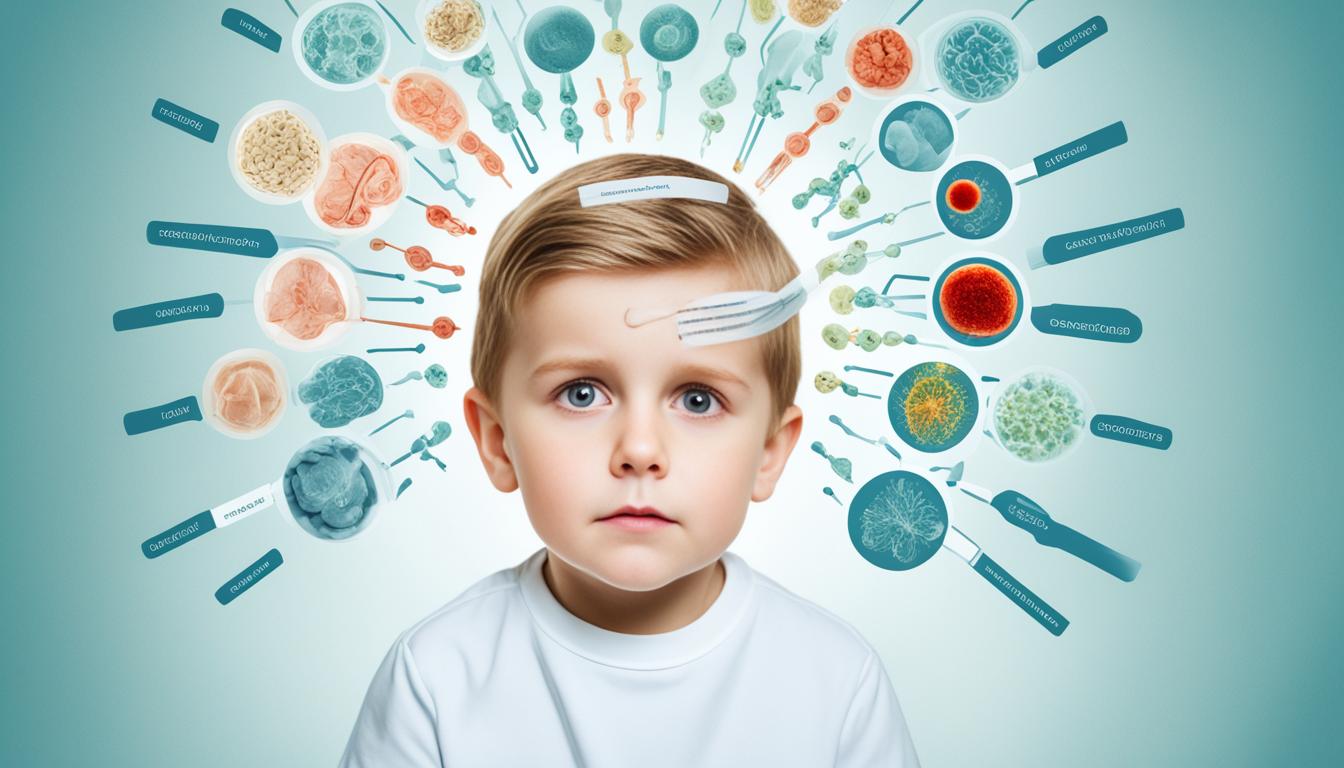Pediatric brain tumors are abnormal cell growths found in the brain or near it in children. They cause symptoms like headaches, nausea, and problems with balance. These tumors come in different types. Some grow quickly, while others grow slowly. It’s key to know that treating brain tumors in kids is different than in adults. This requires specialized care from a hospital that focuses on treating children.
Kids with brain tumors often show signs like headaches, nausea, and changes in vision. They might also feel confused, have seizures, or show weakness. The causes are mostly a mystery but could be related to being young, exposure to radiation, and a weak immune system. Doctors use imaging tests like CT scans or MRIs to diagnose. Treatments for these tumors might involve surgery, chemo, radiation, or stem cell therapy.
Key Takeaways:
- Tumors in the brain can cause issues such as headaches and balance problems in children.
- There are many types of pediatric brain tumors, each with its own growth pace.
- Expert care is crucial for dealing with these brain tumors in children.
- Typical signs of brain tumors in kids include headaches, seizures, and weakness.
- We don’t fully understand what causes these brain tumors, but some factors could increase the risk.
Types of Brain Tumors in Children
Brain tumors in kids come in several types. Knowing these types is important for treatment. Here are common brain tumors children get:
Astrocytomas
In children, astrocytomas are the top type of glioma. They often start in the cerebellum. These tumors range in severity. Treatment can include surgery, chemo, and radiation to kill off any remaining cancer cells.
Medulloblastomas
Medulloblastomas are serious tumors usually found in the cerebellum. They can spread to the spinal cord. Aggressive treatments like surgery, chemo, and radiation are needed. Catching these early means kids have a better chance than before.
Ependymomas
Ependymomas form from ependymal cells in the brain and spinal cord. Depending on where they are, treatment might involve surgery, radiation, or chemo.
Optical Nerve Gliomas
Optical nerve gliomas grow on or around the nerves from the eyes to the brain. Treatments can vary from just watching to radiation or surgery.
Craniopharyngiomas
These rare tumors are near the pituitary gland. They can upset hormone balance. Treatments may include surgery, radiation, or fixing hormone levels.
Kids with brain tumors need care from a team. Specialists like pediatric neurologists and oncologists work together. The best treatment plan depends on the tumor type, its stage, and the child’s health.
Treatment for Child Brain Tumors
Treating child brain tumors combines surgery, chemo, and radiation. The plan depends on the tumor type and where it is. Surgery to remove the tumor comes first. Chemotherapy and radiation follow to wipe out any left cancer cells.
Support and Care
Caring for a kid with a brain tumor is more than just treatments. The child’s family and caregivers are key for support. Getting help from groups that focus on these tumors can provide support, resources, and connect you with others facing similar challenges.
| Type of Brain Tumor | Treatment Options |
|---|---|
| Astrocytomas | Surgery, chemotherapy, radiation therapy |
| Medulloblastomas | Surgery, chemotherapy, radiation therapy |
| Ependymomas | Surgery, radiation therapy, chemotherapy |
| Optical Nerve Gliomas | Monitoring, surgery, radiation therapy |
| Craniopharyngiomas | Surgery, radiation therapy, hormone replacement therapy |
Diagnosis and Treatment of Pediatric Brain Tumors
If a child shows signs of a brain tumor, quick medical help is key. A pediatrician or neurologist should evaluate them. Tests like MRIs will show if there’s a tumor and its location. This is crucial for figuring out how to treat it.
After diagnosis, a neurosurgeon will create a treatment plan. This plan is based on the child’s specific situation. options can mix surgery, radiation, and chemotherapy.
- Surgery: Doctors often have to cut out the tumor. They use very precise methods to do this safely.
- Radiation Therapy: It blasts the tumor with powerful rays to stop it from growing. This can be used if surgery isn’t an option or to kill any left-behind cells.
- Chemotherapy: It uses drugs to kill or slow down cancer cells. It can help after surgery or radiation, too.
What treatment they get depends on where the tumor is, its size, and grade. Each child gets a unique plan to give them the best chance of getting better. After treatment starts, it’s important to keep going to the doctor for check-ups. This is to make sure everything is working and to deal with any problems that might come up.
The child and their family need a lot of care and help during this time. A team of experts work together to look after them. Also, families can find support groups and websites to connect with others and get more help.
| Key Points |
|---|
| Diagnosis involves imaging tests like MRI scans to identify brain tumor presence and location. |
| Treatment options may include surgery, radiation therapy, and chemotherapy, personalized to each child’s needs. |
| Follow-up care is important for monitoring neurological function and addressing treatment side effects. |
| Accessing comprehensive care and support resources can benefit both the child and their family. |
Conclusion
Pediatric brain tumors are tough but progress in treatments gives hope. This includes treatments like stem cell therapy. It’s key to get support from different groups and programs.
Families can join support groups or reach out to organizations that help with pediatric brain tumors. This helps them get the needed support and advice. Being informed and working with a team of health experts means parents can choose the best for their child’s treatment.
It’s crucial to support kids with brain tumors well. Parents play a big role by ensuring their child gets the best care and support. They can help their child fight against brain tumors by getting the right treatments and support.

